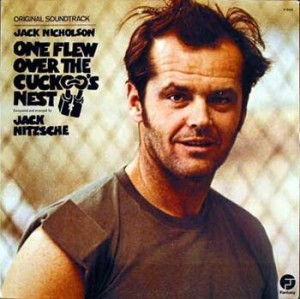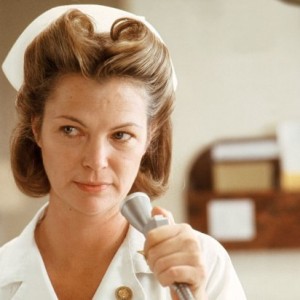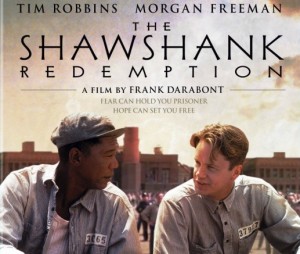Rating: 




 One Flew Over The Cuckoo’s Nest [1975] [DVD]
One Flew Over The Cuckoo’s Nest [1975] [DVD]
This 1975 classic portrayal of how the routine of an American psychiatric asylum turns upside down by one man, a disruptive, rebellious prisoner feigning madness, Randall P McMurphy, who was unforgettably portrayed by Jack Nicholson. It is a deceptively simple story, set within a stiflingly small world, the ward ruled by Nurse Ratched. 
With the potential to fail miserably, considering the bleak setting, it is at turns dramatic, frightening, funny, moving and uplifting. It is based on the 1962 novel of the same name by Ken Kesey, a psychiatric nurse with a serious point well made, the lack of humanity in such institutions of the time. We may well feel we are on familiar ground here, since so many films, novels and TV series have similarly explored the dehumanising aspects of large institutions, for example, hospitals, prisons, schools and military establishments, all having received attention. Needless to say, if not the first, ‘One flew over the cuckoo’s nest’ is a definite front runner. One could draw a comparison with ‘Hamlet‘, set within the confined court of Elsinore, and the central question, “Is he mad or isn’t he”?
The novel ( One Flew Over the Cuckoo’s Nest ) is told through the eye of the narrator, a mute Native American, Chief Bromden. It can take a while to follow him, as he explores the idea that the patients were the only sane, truly human people within a closed society forced into compliance by a powerful, machine-like, autocracy, using drugs and electro-convulsive treatment on the patients, and more subtle means on the lesser staff. The film opted for a more objective, conventional narrative, which reportedly infuriated Ken Kesey. The rumour is that he would never watch the film.
The supporting actors are great, but there is no doubt, however, that it is Jack Nicholson’s portrayal of McMurphy that sets the film apart. McMurphy feigns insanity to be sentenced to what he believes is a cushy mental hospital. But the plan backfires when the hospital turns out to be anything but cushy, with its oppressive routines and a head nurse who is out to quash any vestige of the patients’ personal independence. Free-spirited McMurphy becomes a catalyst for the frustrations of his downtrodden fellow patients and a worthy adversary for the head nurse.
Reminding me of Paul Newman in Cool Hand Luke, ‘Mac’ has led a tough life, has beaten people and has been beaten, imprisoned and accused of rape, but he is the epitome of human, we are completely sympathetic with him, as he retains his identity in the face of the system. He is one of those fantastic free spirits that we all would like to be, a couldn’t care less about your petty rules and regulations, always the right bit of humour to expose the farce of the system, nothing to lose, and nobody to please. It is in this way we really see how institutionalised the ‘chronics’ and the ‘acutes’, as the patients are anonymously segregated, have become.

One of the fascinating things about how the film was conceived lies in its semi-documentary style. Filmed inside a real residential psychiatric hospital, it featured real patients in some scenes, and the role of Doctor Spivey, the boss whose task it is to evaluate McMurphy’s ‘madness’ was played by Dr Dean Brooks, the real head of the institution. Many professionals have noted the film got that depressing, stifling atmosphere just right, down to the sounds in the background, even the depressing colour of the paint on the corridor walls.
Psychiatrist: Dr. Sanji?
Dr. Sanji: I don’t think he’s overly psychotic, but, I still think he’s quite sick.
Psychiatrist: You think he’s dangerous?
Dr. Sanji: Absolutely..
By 1960, with ‘The Myth of Mental Illness’, Thomas Szasz felt disillusioned with psychiatry, wondering whether it was doing more harm than good. Also in 1960, RD Laing was examining why people might play at being mad, and if the response of psychiatrists, sometimes allied with the criminal justice system, was appropriate (The Divided Self: A Study in Sanity and Madness). It has long been noted that for some patients to qualify for rehabilitation, they must accept the conditions imposed by the service; it must surely be tempting for some to simply feign co-operation and acceptance. The refusal to do so of ‘Red’, Morgan Freeman’s character in The Shawshank Redemption, is a major factor in that film’s story.
Is this not a factor when things go wrong? When a tragedy occurs, who then is at fault? In the novel, Scanlon put it well: “ Either conform and be released, or maintain your integrity, and be kept on the ward..” Harding’s take was “This world belongs to the strong, my friend. We must face up to this..we must learn to accept it as a law of the natural world. The rabbits accept their role..and recognize the wolf as strong…the rabbit endures…he knows his place.” In other words, the system of ‘The Asylum’ was dis-empowering the patients. Recognizing this, and eliminating the problem entirely, are two different things.
With a tremendous power to make you think, the movie site http://www.imdb.com/one flew over the cuckoo’s nest has 521 comments on the film! Comments from people with experience of working with the mentally ill, such as, “OK, we don’t put mentally ill people in that kind of lunatic asylum anymore, so the bars in front of the windows have gone and now we call it a hospital instead. But I have seen things like forced feeding, or giving people so much medication until they no longer know who or where they are…” Very interesting to read through, but in context I should say, the novel is expressly condemning much of what people are saying. I believe the care of the mentally ill has radically changed since the novel was written, but the lessons learnt should not be forgotten.
Although I have included Ken Kesey’s novel in my ‘single book author’ category, Kesey published Sometimes a Great Notion two years after One Flew over the Cuckoo’s Nest, and then published two more novels back to back in the nineties: Sailor Song and Last Go Round. But this is the one we really remember..
Why is the novel so named?
“Vintery, mintery, cutery, corn,
Apple seed and apple thorn,
Wire, briar, limber lock
Three geese in a flock
One flew East
One flew West
And one flew over the cuckoo’s nest”
(Chief Bromden’s grandmother sang this song to him when he was young. A playful name for a mental asylum is a “cuckoo’s nest”, and a mentally unstable person can be referred to as “cuckoo”. To ‘fly over a cuckoos nest’ is to go too far, to get yourself in trouble).
(Please note: This film has strong language and some violence/nudity)